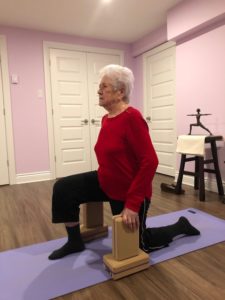
Age 96 and Practicing Yoga for 10 Years!
by Diana Perez, physiotherapist, yoga teacher, yoga therapist
According to the Centers for Disease Control (CDC), physical activity is critical to healthy aging. But often we tend to think that elderly people (anyone over the age of 55) should be exercising carefully and being cautious to not injure or overstrain themselves. So yoga and exercise classes for the elderly often look like this:
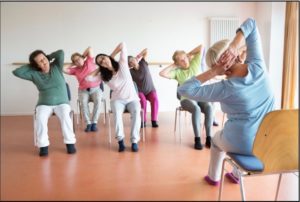
And this might be a good place to start, especially for the frail elderly or with persons that have not recently or ever done yoga or other forms of physical activity. And it may also be the place where a person has to be because of serious health or medical conditions.
But does aging always imply frailty and fragility? Is gentle and low intensity yoga/exercise really the best and only way to approach movement as we age? Should older people always avoid pushing themselves too hard when doing yoga/exercising because of risk of injury or worsening a medical condition?
Here are some things to think about in pondering on these questions:
- Older adults do tend to have more chronic disease conditions and many have been inactive for decades, have very low levels of fitness or have never really exercised before. But with a person specific yoga and/or exercise program, good self-awareness, appropriate guidance, and the gradual progression of the program, the chances of getting injured are usually quite low.
- The two most prevalent chronic conditions among older adults are osteoarthritis and hypertension. Yoga and/or exercise are recommended interventions for both of these conditions, as well as for almost every other chronic disease, and should be done at a level intense enough to solicit physiological adaptations. Please keep in mind that individuals with serious health issues should be screened by their doctor and any other relevant health care professional before starting a more intense exercise program, but they should not be necessarily limited from more intense or challenging yoga or other physical activities if they are cleared medically.
- Older adults are often skeptical of doing some new and more challenging yoga or other exercise activity not because they don’t want to try new things but because they have never done anything like this before, don’t know what to expect, and are concerned that they might get hurt. They also often don’t want to be embarrassed by doing something stupid or wrong. Usually, it is the fear of the unknown combined with low self efficacy (belief in oneself) that causes them to hesitate. However, this is pretty easily overcome by some positive experiences, including being led by an empathetic and experienced yoga teacher/trainer and being with other folks like themselves. Once they realize that this type of activity is possible for them, that it is fun and that they can do it, they are usually keen to try different and more challenging experiences.
- Just because an individual is older, does not mean they are frail or fragile. And just because they have a condition doesn’t mean that they are “sickly.” Many older adults are robust and healthy, even though they might be relatively unfit. Often it is possible to progress their yoga/exercise activity to more challenging levels if it is done gradually and carefully. There are a large number of scientific studies that indicate that older adults have very favorable physiological adaptations to more demanding exercise. Age should not be considered a limiting factor to more intense physical activity/yoga.

- Older adults are extremely diverse in their physical abilities and needs, which means yoga and other forms of exercise should ideally be done with an experienced teacher or trainer as one-on-one or small-group classes. As with any yoga class, the person should be encouraged to safely explore limits with awareness, curiosity, and confidence.
Here are some more photos of my mom doing yoga at 95 years old. She only started doing yoga about 10 years ago. She turned 96 this year and is still going strong!
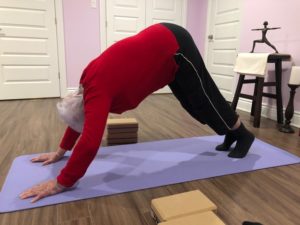
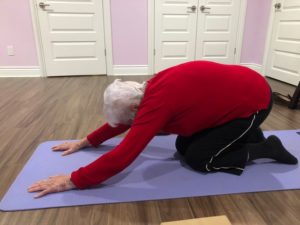
As you can see, yoga for the elderly does not always have to be limited to chair yoga! There are numerous benefits to including standing poses with different levels of support, poses that encourage people to get on and off the floor, and poses that are practiced on the floor in different positions that encourage movement in all planes (sides and the front as well as back of the body). This may not always be possible in a large group class because it may be unsafe for some or all of the participants to move in these ways without additional personnel and/or props.
Final Food for Thought
I think it would be helpful to consider following questions before guiding the elderly into more demanding yoga poses and programs:
- Are there any biases or preconceived stereotypes by either the participants or teachers that may be limiting the way that yoga is being practice by this age group?
- Has the person been medically cleared for more intense physical activity?
- What is the person’s current fitness level and prior experience with yoga?
- Would a one-on-one yoga class rather than a small group class be better suited to this person, at least initially (especially if they are less experienced with yoga or less fit)?
- Does the size of the group class allow for close supervision, individual guidance, and safety of the participants?
- Does the teacher have enough training, experience, and specific personal knowledge about the person’s physical condition(s) to understand how to teach and progress a program or class for them?
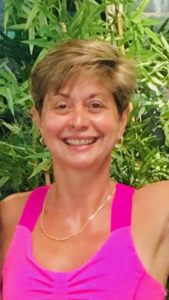
Diana Perez is a sports and rehabilitation Physical Therapist and a certified Professional Yoga Therapist (PYTI-2017) who has worked in the medical field, academia, and fitness industry for over 40 years. She completed a Masters Degree in Rehabilitation Science in 1997 (Faculty of Medicine; McGill University) and was a lecturer / professor at the School of Physical & Occupational Therapy; Faculty of Medicine (McGill University) from 1985-2004. She has advanced specializations in Sports Physiotherapy, Manual Therapy, Back & Neck Rehabilitation, Muscle Energy, and Myofascial Release, She also has formal training/certifications in the areas of wellness, functional nutrition, naturopathy, Ayurvedic medicine, acupuncture and yoga therapy, and has been integrating yoga into her clinical practices since 2004.
Diana Perez has been practicing yoga since 2002 and teaching yoga since 2004. Her yoga influences have been mainly from the schools of Hatha, Ashtanga, Moksha and Anusara and she completed 2 teacher training certifications (Hatha & Ashtanga; RYA-200 hours). Her specialties are in Yoga Therapy, Yoga Anatomy, Injury Prevention, Asana Alignment, and Yin Yoga. She is on the faculty of several Yoga Teacher Training Programs in Canada (Sun and Moon; Heaven & Earth; Happy Tree; Moksha WI Yin), and teaches yoga classes and many types of workshops to yoga teachers as well as to the general public. She is also on the faculty of the Atlas-Medic Medvox Program for who she develops and teaches courses to health care professional on how to integrate yoga into health care. She currently continues to practice as a physiotherapist and yoga therapist at the Medi-Club Physio Centre in the West Island of Montreal.
• Follow Yoga for Healthy Aging on Facebook and follow Nina on Instagram •Pre-order Yoga for Times of Change: Practices and Meditations for Moving Through Stress, Anxiety, Grief & Life’s Transitions here. • Order Yoga for Healthy Aging: A Guide to Lifelong Well-Being here


Love your post!
I teach a small group class of older women and we were discussing this topic last week. We all agree that for now we enjoy our more vigorous mat practice. For us, chair yoga is for when we are watching television or stuck in a chair doing our taxes.
Sometimes when one of our participants is returning following surgery or illness they practice in a chair while the rest of us do our normal practice. So sometimes I teach chair yoga and mat yoga at the same time.
I particularly enjoyed the pictures of your lovely mother practicing her yoga.